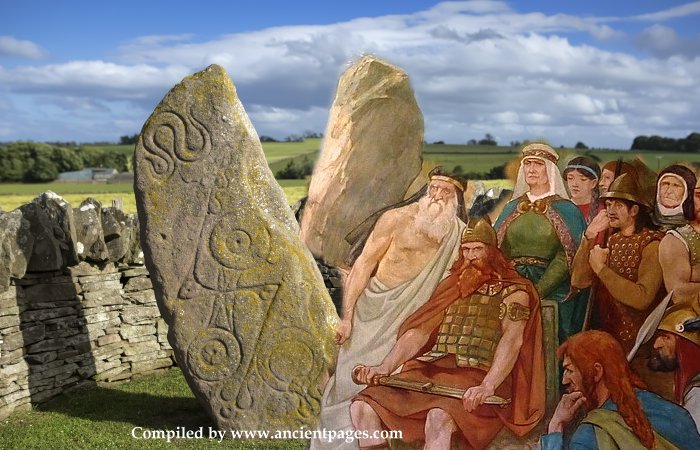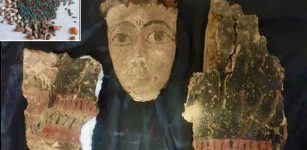Extraordinary Kite-Shaped Pictish Ring Found At Moray Fort In Scotland
Jan Bartek - AncientPages.com - The archaeological excavation at the Burghead fort in Moray has yielded a significant discovery: a Pictish ring with an intricate setting. This find is particularly noteworthy given the site's previous reputation as being "archaeologically vandalized" due to the construction of a new town in the 1800s.
The Pictish ring photographed by National Museums Scotland. Credit: NMS
The ring, described as kite-shaped with a garnet or red glass center, had remained hidden for over a millennium. It was unearthed during a dig led by the University of Aberdeen, with the discovery made by a volunteer.
Burghead fort, known to be a Pictish site, was long thought to have lost much of its historical value when the town of Burghead was built. The construction process involved covering a large portion of the fort and repurposing the remaining stones for building materials.
John Ralph, the volunteer who made the discovery has a unique connection to the site. His ancestors were among the families encouraged to move to Burghead in the 1800s to support the local fishing industry. Ralph, a former engineer and University of Aberdeen graduate, joined the excavation efforts after seeing a social media post by Professor Gordon Noble, the University's Professor of Archaeology.
The Picts, though enigmatic, played a crucial role in Scottish history. These valiant and resolute people successfully resisted Roman and Anglian invasions and won a key battle in Scotland's past. Read more
Professor Noble has been leading the excavation work at Burghead for the past three years, funded by Historical Environment Scotland. These efforts have revealed new insights into the site's importance and enabled the creation of 3-D reconstructions of its possible original appearance.
The ring was discovered on the last day of the final dig, after Ralph had spent two weeks finding what experts had jokingly referred to as "shiny pebbles." A fellow volunteer initially recognized the significance of the find, highlighting the collaborative nature of archaeological fieldwork.
John Ralph with the ring. Credit: National Museums Scotland
This discovery underscores the potential for significant finds even in sites previously considered compromised and demonstrates the value of continued archaeological investigation and volunteer participation in such projects.
"John was digging and then came over and said ‘look what I’ve found’. What he handed over was incredible,” he added.
Even before the conservation work we could see it was something really exciting as despite more than a thousand years in the ground we could see glints of the possible garnet setting.
There are very few Pictish rings which have ever been discovered and those we do know about usually come from hoards which were placed in the ground deliberately for safekeeping in some way. We certainly weren’t expecting to find something like this lying around the floor of what was once a house but that had appeared of low significance so, in typical fashion, we had left work on it until the final day of the dig," Professor Noble says.
The ring is currently with the National Museum of Scotland’s Post-excavation Service for analysis and John, who grew up in Burghead, is delighted to have added his own piece to the puzzle in understanding the region’s Pictish past.
The ring when found in John's hand. Credit: National Museums Scotland
“It is a real thrill to dig up an artefact in the knowledge that you are probably the first person to see it for 1000-1500 years,” he said.
“It becomes a real guessing game of who owned it, what did they use it for and how was it lost.”
Professor Noble and his team will use the ring and other evidence uncovered on the dig to start to answer those questions.
Professor Noble added: “We will now look at the ring, evidence of buildings and other artefacts to consider whether the ring was crafted on the site and who such an important piece of jewellery might have been made for.
The ring when found side view. Credit: National Museums Scotland
“We have some other evidence of metalworking and the number of buildings we have uncovered is quite striking. This further indicator of the high-status production of metalwork adds to the growing evidence that Burghead was a really significant seat of power in the Pictish period.”
See also: More Archaeology News
In a press release, Susan O’Connor, Head of Grants at Historic Environment Scotland, said: “Given Scotland’s remarkably rich history, it shouldn’t be surprising that we are still uncovering important pieces of Scotland’s past, even where we least expect it. We are proud to have funded and supported the excavation work conducted by the University of Aberdeen. We are delighted that volunteer John Ralph played such a pivotal role in bringing it to light - literally!
“Whilst the materials used themselves are not particularly valuable in today’s monetary sense, this find is hugely significant for what it tells us about Pictish lives and society. We’re excited to find out more once our colleagues in the National Museum have finished their investigations.”
Written by Jan Bartek - AncientPages.com Staff Writer

























